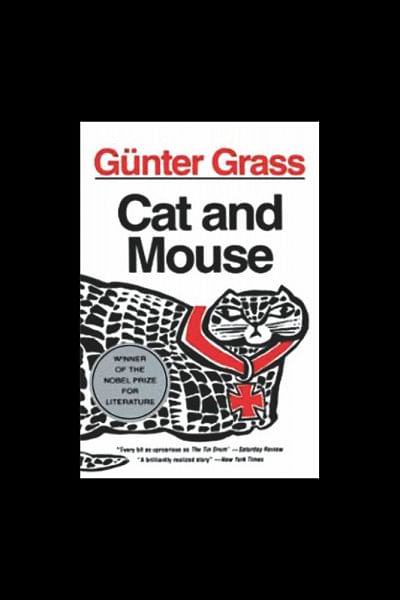Cat and Mouse By Gunter Grass

I bought a copy of Cat and Mouse by Gunter Grass (1927—2015) around four years ago from Aziz Super Market, Dhaka and while going through the moving novel Gunter Grass seemed to me very close to Victor Hugo in terms of characterization. The bizarre physical and mental features of his protagonists in The Tin Drum and in Cat and Mouse reminded me of some of the people Victor Hugo portrayed in his novels Hunchback of Notre Dame and The Man Who Laughs taking into account the inevitable pathos that underpin the frisky narrative mode of the author. Another notable point about Gunter Grass is most of his fictional works are discourse novels due to frequent shifts in point of view while telling the story. The ambience of World War II is strongly felt while reading most of his books. He was awarded Nobel Prize for literature in 1999.
In Cat and Mouse, the mouse allegorically refers to the dreary state of ordinary men and women in society while the cat symbolizes the vicious role of a predator taking advantage of the unprotected plight of naïve and vulnerable people. In Cat and Mouse, Joachim Mahlke, a teenage German boy grows up with the freakish desire of becoming a clown. He and his friends used to dive into the sea to look for treasures in the relics of sunken ships. One day a German submarine captain visited his school and delivered a speech on the glory of war. It was the time while the winds of World War II just started to blow across Europe. Joachim Mahlke had been mischievous since his childhood. He stole that captain's iron cross, even though he was later on caught and rusticated from the school for this offence. However, he received training in a German military academy and joined World War II. He proved his worth by destroying a large number of enemy tanks by means of which he secured his own iron cross for courage under fire. He had an unusually big Adam's apple (larynx) which clearly differentiated him from his fellow soldiers. When he returned to his boyhood school, the principal didn't allow him to speak to the audiences on his war experience because of the theft he had committed several years earlier. This incident upset Joachim Mahlke and he left his military job. The novella ends with Joachim Mahlke diving once again into the sea to search for wreckage but he doesn't return any more. Naturally, it seems to the readers that Mahlke disappeared because of the school principal's denial to recognize his achievement as a brave soldier. The principal's stony attitude may be considered the ''cat'' in this context while Mahlke is the victim of the cat's repugnance.
Gunter Grass to some extent stands on equal terms with the finest ever French novelist Victor Hugo keeping in view the absurdities both these authors depicted in their fictional figures. Les Miserables is Victor Hugo's masterpiece. However, in Victor Hugo's another widely perused novel Hunchback of Notre Dame readers come across a physically deformed man called Quasimodo who is the protagonist of the novel. Quasimodo is found saving a girl named Esmeralda from execution. The unavoidable contrast between the physical deformities of Quasimodo and the beauty of Esmeralda underlines the focal theme of the novel that denies the differences between humans in terms of physical merits and demerits. Oskar Matzerath in The Tin Drum is a dwarf with great drumming skills and he can be compared with Quasimodo in Hunchback of Notre Dame in light of the physical shortcomings they were born with but these corporeal handicaps did not prevent them from doing extraordinary things in these novels. The value of humanity cannot be underrated just for the matter of looking fine or odd—that's the message we receive from both The Tin Drum and Hunchback of Notre Dame.
In another much acclaimed novel The Man Who Laughs, Victor Hugo illustrated a boy whose face was mutilated by a gang of thugs who maimed stolen children and forced them to beg on the streets of French towns and countryside. The boy's face was distorted by the gangsters in such a way that it seemed that he was laughing all the time. He performed various tricks for a circus band owned by the gang. The forcibly incised smile on his face to entertain the audiences who had no idea what a horrendously inhuman story was hiding behind the grotesque face of that boy. So, physical malformations once again get Victor Hugo close to Gunter Grass when we look at the portrayal of that ill-fated boy in The Man Who Laughs and the dwarfish appearance of Oskar in The Tin Drum and also Joachim Mahlke's abnormally huge Adam's apple in Cat and Mouse.
According to Aristotle, authors and poets should aim to simultaneously entertain and educate the people who listen to their verses and read their stories. Standing beside the downtrodden class of people in society is the greatest responsibility of mankind and litterateurs are gifted with the power to play this role in a more comprehensive way than those belonging to other avocations.
The reviewer is a Lecturer, Department of English, Metropolitan University, Sylhet

 For all latest news, follow The Daily Star's Google News channel.
For all latest news, follow The Daily Star's Google News channel. 



Comments